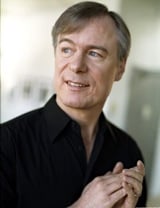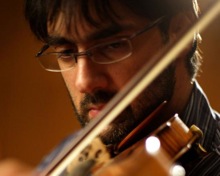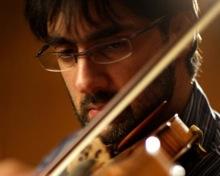The Jan. 26-28 San Francisco Symphony program looked uncannily symmetrical, right down to the D-P pattern of the composers’ last names. First came Paul Dukas’ The Sorcerer’s Apprentice, followed by Prokofiev’s Violin Concerto No. 2. After intermission, the debut of Avner Dorman’s Uriah: The Man They Wanted Dead was paired with another Prokofiev work, his Symphony No. 1 (the Classical).

The correspondences were more than merely alphabetical. The concerts began and ended with the best-known works, each of which conjured strong associations. Thanks to Fantasia, the phantasmagoric 1940 Disney film, Dukas’ Apprentice was once and forever fused to Mickey Mouse and his nightmarishly marching and multiplying broomsticks. Then there was the hey-I-know-that Gavotte from Prokofiev’s Classical Symphony, which the composer later repurposed in his famous Romeo and Juliet ballet score. As for the two D-items on the bill, both the Dukas and the Dorman were programmatic works full of overt drama and orchestral color — and not a great deal more than that.
The evening’s richest and most gratifying music came in the longest and most substantial piece, Prokofiev’s ravishing G-Minor Violin Concerto. At Friday’s concert, with two performances under their belts, soloist Leonidas Kavakos and the Symphony, under David Robertson’s baton, were in sweet accord. With a lucid and strategically understated Allegro as a first-movement foundation, Kavakos and the orchestra rose to the poignant lyrical heights of the Andante. That middle movement seemed in turn to fuel the final Allegro’s feverish intensity. It was all of a piece, thought through and felt through from beginning to end.

Kavakos was reserved in the early going. Playing alone in the concerto’s opening measures, he stated the movement’s melodic motif without trying to claim it too strongly as his own. The soloist’s light vibrato and a tendency to look down at his feet rather than out at the audience reinforced the impression. But the aversion to showiness was well-judged. Kavakos and Robertson knew what they were after, a clear yet nuanced conversation of themes, rhythmic patterns, and key changes that came off as both natural and serious. Kavakos punctuated it all decisively, with a closing flourish of double stops and pizzicatos.
The soloist’s tone bloomed open in the Andante, with Robertson setting it off perfectly. The orchestra’s plucked ground bass was moist and ripe. The strings responded tenderly to the opening material. An exchange of stuttering repeated notes and slight rhythmic dislocations tinted the movement with fresh light. Kavakos yearned skyward in a gorgeous aria set winging high above the ensemble, all of it brought peacefully to earth by the softly plucked cellos. In a wonderfully pungent, half-reckless final movement, Kavakos shed his early demeanor, striding forward, peering out intently at the house, gesturing emphatically with his bow, hitting every note and interpretive inflection along the way. He had been seized by the music, it seemed, as fully as his listeners were.
Based on the Old Testament tale of David and Bathsheba, Dorman’s Uriah takes the part of a loyal soldier (Bathsheba’s husband) who was sacrificed to the lustful whim of his commander. In remarks from the stage, the composer compared the Biblical story to the current wars in Afghanistan and Iraq and described his piece as “social commentary about leaders who send people to war for their own gain.”
The 15-minute work, a San Francisco Symphony commission, began with a bang. Lots of them, in fact, in a percussion assault followed by a sequence of titanically layered and clotted chords, the section is marked Andantino Indignato. Dorman then set out to depict an ominously languid preamble to war, the furious battle itself, a subsequent Song of the Angels in tribute to the slaughtered hero and an Epilogue. For all the percussive outbursts and keening strings, the massively congested chords and skittering woodwind and piano passages, Uriah never developed much traction or momentum. Dorman seemed to be obsessively retraveling the same turf, the same set of raw and underdeveloped musical ideas. Forcefully put as they were, the rage and lamentation remained at the level of an aural spectacle.
Robertson, music director of the St. Louis Symphony, has proved himself a witty presence on the podium in past visits here. So it was a bit of a letdown to find his sense of humor challenged in a rather deliberate reading of the Dukas. There was plenty of the requisite clomping and stomping in his Apprentice. Peaked hats off to the bassoon section, for their especially lively steps. But an antic, frantic edge to the piece went missing.
The conductor’s humor and verve came bristling to life in Prokofiev’s trim and spry Classical Symphony of 1917. From ths swift changes of mood and direction in the opening movement to the high-spirited sprint of the Finale, Robertson had everything running with a bright high gloss and canny dynamic glints. Prokofiev’s neoclassicism is full of smiles at itself, and Robertson reflected them all, winking at the music even as he and players gave it full measure. Brimming over at the end, the floppy-haired conductor motored back and forth across the stage during the ovation, exchanging words with the last chair occupants of the violin and double bass sections. This was a group effort all the way, he seemed to be saying, his face lit up in a big, slightly goofy, all-embracing grin.

